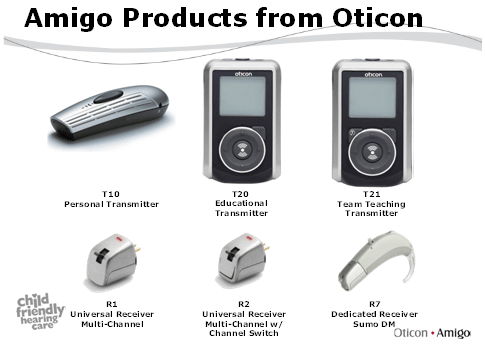Advanced technology hearing aids allow tremendous capabilities for people with hearing loss, providing benefits such as: improved signal-to-noise ratio, reduced background noise, high fidelity sound quality and a multitude of other advantages. Unfortunately, despite these beneficial functionalities, hearing aids cannot completely overcome three important factors which adversely impact hearing impaired people: background noise, distance and reverberation. Children with hearing loss are at a greater disadvantage than are adults and require a greater signal-to-noise ratio (Smaldino and Crandell, 2000).
Fortunately, classroom FM systems are very effective in managing these same factors (background noise, distance and reverberation) and FM systems can facilitate dramatic improvements with respect to speech recognition in noise (Chisolm, McArdle, Abrams and Noe, 2004).
This article will present an overview of the rationale for FM systems, expected outcomes and challenges of classroom FM for children with hearing loss and a brief description of new FM products.
Introduction
Hearing is pivotal to the development of normal speech, language, cognition and auditory processing abilities. For the majority of students, classrooms are oral-aural environments; teachers instruct via voice and children/students listen and respond. Children spend three-quarters of their day in listening environments, and listening is the cornerstone of the educational experience (Schmidtke-Flynn, Flynn & Harvey, 2004).
Flexer (2005) noted data input precedes data processing. Sounds which cannot be heard cannot be processed. Sound must be detected, discriminated, recognized, identified, and is then, finally, comprehended. If a child cannot clearly hear speech, he/she cannot maximally process sound. Flexer (2005) noted when children cannot hear spoken instruction, the entire premise of the educational system is undermined. A multitude of other factors can negatively impact the educational experience; English as a second language, word knowledge and level of difficulty, context, knowledge of language rules and syntax, type and degree of hearing loss, auditory processing disorders, attention deficit disorder, developmental disabilities, foreign accents, otitis media and other factors.
Children require far greater advantages with respect to the speech signal, than do adults (Smaldino and Crandell, 2000). Adults function better in challenging acoustic environments as they can accurately predict and fill-in words and meanings based on previous knowledge and experience not yet acquired by children.
Therefore, hearing and cognition are two of the pillars upon which education relies. However, acoustic challenges in the educational setting are also formidable. Unfortunately, typical classrooms often present acoustical barriers to listening and learning - not only for hearing impaired children, but for children with normal hearing (Lewis, 1994; Smaldino and Crandell, 2000; Busset, n.d.). Many authors have addressed the benefits of FM systems for normal hearing children with auditory processing disorders (APD) as well as hard-of-hearing children (Weihing, 2005; Bamiou, Musiek and Luxon, 2001).
FM systems have been shown to reduce noise and distractions in the acoustic environment, while improving figure-ground listening problems, listening fatigue and teacher stress (Cleveland, 1997). FM improves the signal-to-noise ratio, eye contact, speech perception and speech recognition (Geffner, 2005; Ciocci, 2002).
Acoustic Considerations
Acoustics are particularly important for educational settings. Three acoustic factors of particular importance are: distance (from talker to listener), signal-to-noise ratio and reverberation.
Distance and the Inverse Square Law
Boothroyd (2005) noted at one foot, the long term average level of speech is 72 dB SPL. The Inverse Square Law states loudness decreases at 6 dB per distance doubling. Therefore, at four feet, average speech is 60 dB SPL, at 8 feet 54 dB and at 16 feet the long term average speech loudness is 48 dB SPL. Distance quickly degrades sound and in fact, soft speech can actually "disappear" from one end of the classroom to the other. Children in this situation often appear confused, or may exhibit behavioral problems as they are not receiving the complete auditory signal.
Signal to Noise Ratio
There are multiple noise sources within each classroom. When speech and noise are of equal loudness the signal-to-noise ratio (SNR) is 0 dB. Given 0 dB SNR, the theoretical maximal speech audibility is 50%. As the SNR increases to +15 dB (speech 15 dB louder than noise) speech audibility increases to 100 percent. As the SNR decreases to -15 dB (speech 15 dB quieter than noise), speech audibility decreases to 0 percent. However, speech and noise are dynamic and they have amplitude peaks and valleys varying by +/- 15 dB. Therefore, to maintain 100 percent audibility, a theoretical SNR of +30 dB is required.
Reverberation
In an infinitely large room there is no reverberation. As room size decreases and as reflective surfaces increase, reverberation increases. Reverberation time (RT) is the time required for sound to decrease by 60 dB, upon sound cessation. As RT increases, speech intelligibility decreases. Acoustic treatments such as carpets rather than tile floors, acoustic tile rather than shiny walls and ceilings, acoustically absorbent furniture and fixtures within the room etc., help to decrease reverb.
With respect to solving the three acoustic factors presented above (distance, background noise and reverb), Boothroyd noted (2005a) there are three options:
- Modify the acoustics of the room.
- Engage a sound-field system.
- Use a personal FM system.
Expected Outcomes: FM Technology and Children
Although acoustic challenges in the classroom (noise, distance and reverberation) are formidable, FM technology significantly improves all three obstacles. By wearing a close, wireless microphone, the primary speaker's voice (teacher) is delivered as the primary (i.e., loudest) signal to the child, louder than the background noise. This can be further enhanced through adjustment of the FM gain, in relation to the hearing aid or primary amplification device gain, to ensure maximal signal-to-noise ratio for the specific child's auditory environment.
Close-up microphones overcome the physical distance between the child and the teacher, allowing the child to hear the teacher as if he/she were speaking 3-6 inches from the child's ear. Therefore, the microphone configuration determines the distance factor. Speech perception is increased as the distance between the talker's mouth and the microphone decreases.
Wireless transmitters eliminate negative factors relating to acoustic considerations (see above). FM technology allows the greatest access to auditory information for optimal learning, and allows the teacher to move about the classroom without negatively impacting the quality of the speech information delivered to the child wearing the wireless FM receiver.
FM in the Classroom
Personal FM has recently evolved significantly. FM systems previously meant large body-worn units with fabric harnesses. Currently, ear-level wireless receivers which attach to the child's personal hearing instruments are the norm. These smaller, more advanced FM systems facilitate more consistent FM usage in the classroom, less stigma, and lead to greater academic success for the child.
Nonetheless, even advanced FM systems can present a number of challenges for mainstream classroom teachers who sometimes find themselves teaching hearing impaired children. The teacher may have little or no knowledge regarding hearing loss, hearing aids, FM systems or the auditory needs of the child. Sometimes, with little or no training, teachers must become adept at using FM transmitter/microphones, and connecting FM adapter shoes and receivers to various hearing aids Assuring each child's FM system is working properly throughout the day poses an additional burden on the teacher.
Defining and Discovering FM Problems
Oticon, along with sister company Phonic Ear, interviewed many educational audiologists to define problems and explore solutions relating to existing FM devices in the classroom. The information obtained through these interviews became part of the development process for Amigo, Oticon's new personal FM system. Identified priorities included: verifying and ensuring proper function; reducing downtime; prioritizing the teacher's speech; simplifying the programming and troubleshooting processes; and lastly, compatibility of FM components with existing systems.
Addressing and Implementing FM Solutions
- Verifying and Ensuring Proper Function:
Older body-style FM transmitters and receivers offered a helpful light that glowed to indicate the FM signal was sent and received. Smaller BTE-based FM systems have not previously offered this feature. Therefore, teachers desiring verification of the child's FM system previously had to perform a biological listening check. Amigo solves this problem with a built-in LED light on the receiver. The glowing LED indicates the receiver is turned on, is receiving power from the hearing aid battery and that the FM signal is being received and is on the proper channel. This instant feedback gives teachers and children confidence in the FM system. The light blinks to confirm the Amigo transmitter and receiver are synchronized to the same channel. For older children, the LED can be disabled as desired. - Reducing FM downtime:
Teachers are busy. They simply do not have extra time during their work day and they cannot be concerned about kid-glove treatment for fragile FM systems. Dropping transmitters to the floor and/or handling FM systems with sticky, wet fingers often meant the FM system might stop working. The Amigo's outer case and internal design for the transmitter and receivers were developed to withstand more than the typical classroom delivers. Ultrasonically welded seams, molded rubber frames, silicone rubber-sealed keypads and gold plated contact pins are the standard components, and they are highly resistant to moisture, repeated droppings and thousands of button-pushes. To further reduce downtime, the Amigo rechargeable battery can be replaced with a standard alkaline cell if/when needed. - Prioritizing Speech Sounds:
FM systems receive the teacher's voice via the microphone and transmit it to the child's receiver. However when the teacher stops speaking, other noise sources (heating, ventilation, air conditioning, other children, etc.) present noise into the FM microphone.
Amigo uses advanced speech processing to maximize speech, while minimizing noise. By applying speech detection and noise reduction strategies, the cleanest possible speech signal is transmitted. When the teacher stops speaking, the Amigo transmitter automatically attenuates the microphone signal. For teachers not using a boom microphone, Amigo uses a WDRC strategy and automatically compensates for varying microphone placement on the upper body. When the microphone is worn by a different teacher with a louder or softer voice, the output level is automatically adjusted to provide the child with a consistent and comfortable signal. - Simplifying the fitting and troubleshooting process:
Educational audiologists often travel between schools and have to be prepared for any needed FM troubleshooting. Special software, an accessible computer or portable laptop, programming cords and hardware can be cumbersome to transport and time-consuming to set-up.
Amigo addresses these problems by providing menu-driven, software-based programming and troubleshooting 'hardware' in a hand-held unit - the transmitter itself. Every programming parameter for the transmitter and receiver is programmed using the transmitter. Channel selection, disabling or enabling receiver switches, programming accessible channels and more can be accomplished in just a few minutes. Important settings such as FM gain can be programmed wirelessly and live, sitting across from the child or can be accomplished using a hearing aid test box. If needed, the audiologist can talk the teacher through the troubleshooting menus remotely. - Compatibility:
Schools often don't have the financial resources to replace FM equipment annually. Therefore, FM systems must be compatible with existing systems and other manufacturers' hearing instruments. Amigo operates on 32 channels within the 216 MHz range and is compatible with all other "216-based" FM and soundfield systems. The large number of available channels (32) is beneficial for schools with a high density of FM usage. Amigo receivers are compatible with cochlear implants, and with most BTE instruments using the universal 3- Europin connection.

Figure 1. The Amigo line of products from Oticon.
Summary
FM systems are extraordinarily useful and highly beneficial for hearing impaired children and others who benefit from a better signal-to-noise ratio.
Innovative design and creative problem solving have fostered the development of the Amigo FM system, which address and successfully manages many of the previous FM system shortcomings. Efficient verification of a constant FM signal, reduced downtime, increased durability, prioritized speech sound processing, simple protocols executed via hand-held devices and compatibility across hardware options, all help assure an excellent educational experience.
Advanced FM technology, such as Oticon Amigo, offers significant advantages to assure each child has maximal access to their auditory environment for optimal success in the classroom.
Please Note: This article was previously distributed to audiology graduate students as a supplement to the Hearing Journal, June, 2006.
References
Bamiou, D-E, Musiek, F.E. & Luxin, L.M. (2001). Aetiology and Clinical Presentations of Auditory Processing Disorders - A Review. Arch. Dis. Child, 85(5), 361-365. adc.bmjjournals.com/cgi/content/full/85/5/361
Boothroyd, A. (2005). Room Acoustics and Speech Perception: The Basics. Phonic Ear by FrontRow for Active Learning SFTutorial 1.5, November 2005.
Boothroyd, A. (2005a). Modeling the Effects of Room Acoustics on Speech Reception and Perception. In Crandell, C.C., Smaldino, J.J. and Flexer, C. (Eds.), Sound Field Amplification: Applications to Speech perception and Classroom Acoustics 2nd Ed., (pp. 23-48). Thomson Delmar Learning.
Busset, P. (n.d.). Hearing Services for District Students. In - Nassau Board of Cooperative Educational Services, Special Education, Hearing Services for District Students. Retrieved April 17, 2006, from www.nassauboces.org/sped/student_svcs/hearing.htm
Chisolm, T.H., McArdle, R., Abrams, H. & Noe, C.M. (2004). Goals and Outcomes of FM Use by Adults. Hearing Journal, 57(11), 28-35.
Cleveland, S. (1997). Central Auditory Processing Disorder: When is Evaluation Referral Indicated. The ADHD Report, 5(5). Retrieved April 17, 2006, from www.ldonline.org/article/6146
Ciocci, S.R. (2002, December). Auditory Processing Disorders: An Overview. ERIC EC Digest #E634. Retrieved April 17, 2006, from ericec.org/digests/e634.html
Flexer, C. (2005). Rationale for the Use of Sound Field Systems in Classrooms: The Basics of Teacher In-Services. In Crandell, C.C., Smaldino, J.J. and Flexer, C. (Eds.), Sound Field Amplification: Applications to Spech perception and Classroom Acoustics 2nd Ed., (pp. 3-22). Thomson Delmar Learning.
Geffner, D. (2005). Evidence Based Practice in the Treatment of APD." ASHA presentation 2005, by Donna Geffner, Ph.D., CCC-SP/A. St. John's University. Retrieved April 17, 2006, from convention.asha.org/2005/handouts/293_Geffner_Donna_072622_111505015102.PPT
Lewis, D.E. (1994). Assistive Devices for Classroom Listening: FM Systems. American Journal of Audiology, 3(2), 70-83.
Schmidtke-Flynn, T., Flynn, M.C. & Harvey, M. (2004). The FM Advantage in the Real Classroom. Audiological Research Documentation, News From Oticon, December.
Smaldino, J.J. & Crandell, C.C. (2000). Classroom Amplification Technology: Theory and Practice. Language-Speech and Hearing Services in Schools, 31(4), 371-375.
Weihing, J. (2005). FM Systems as a Treatment for CAPD. Hearing Journal, 58(10), 74.


